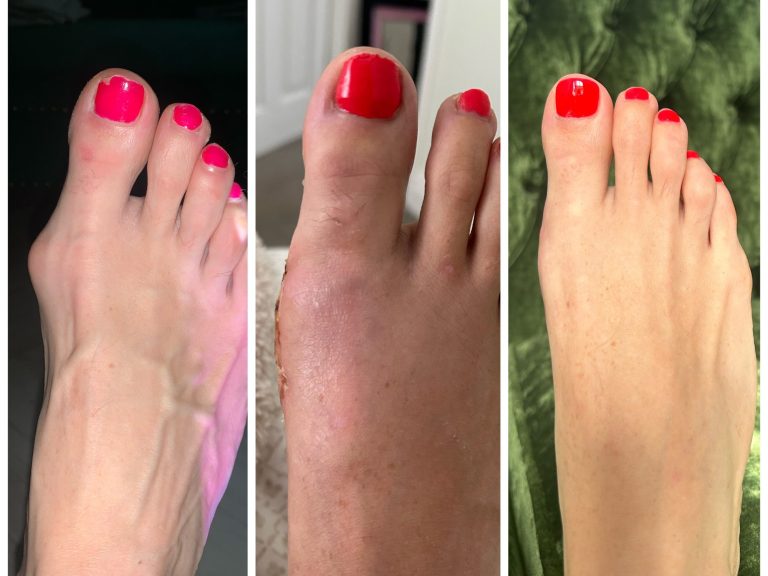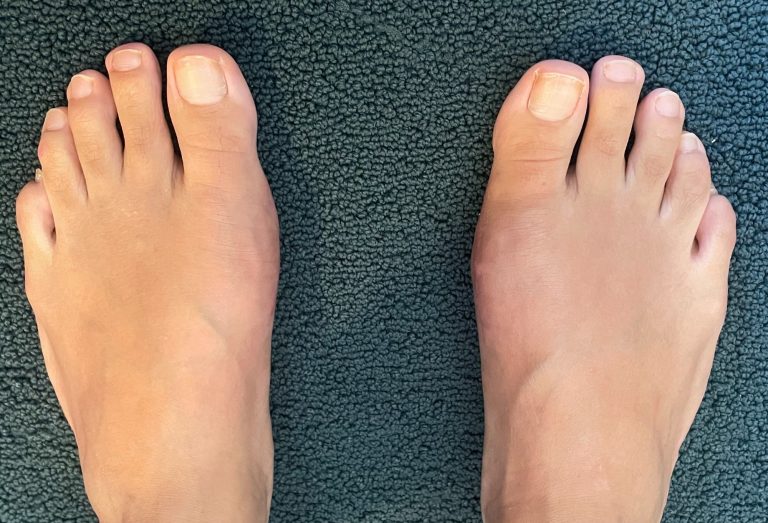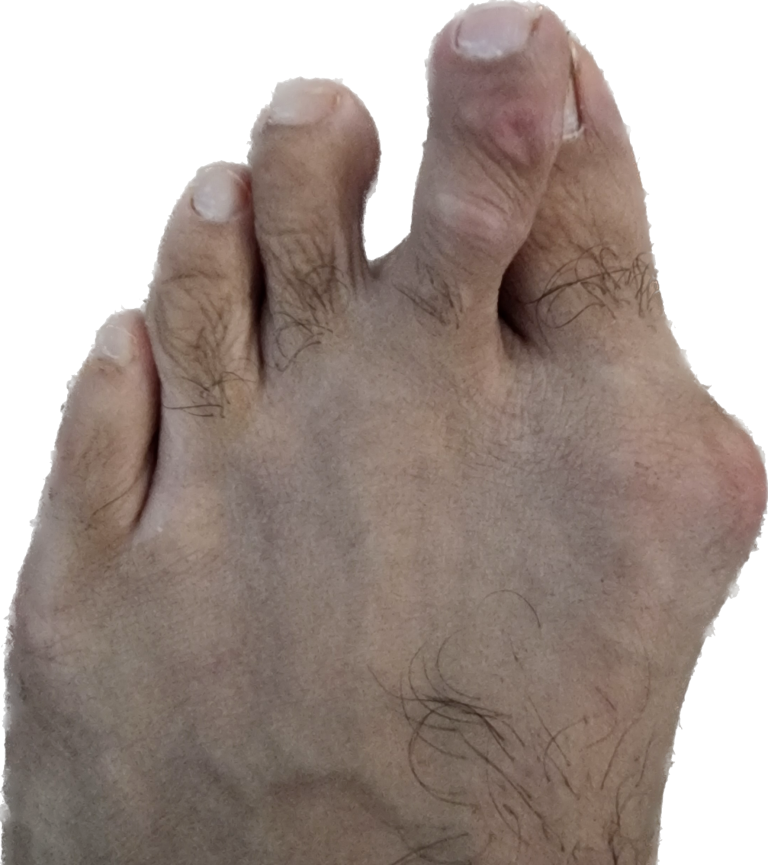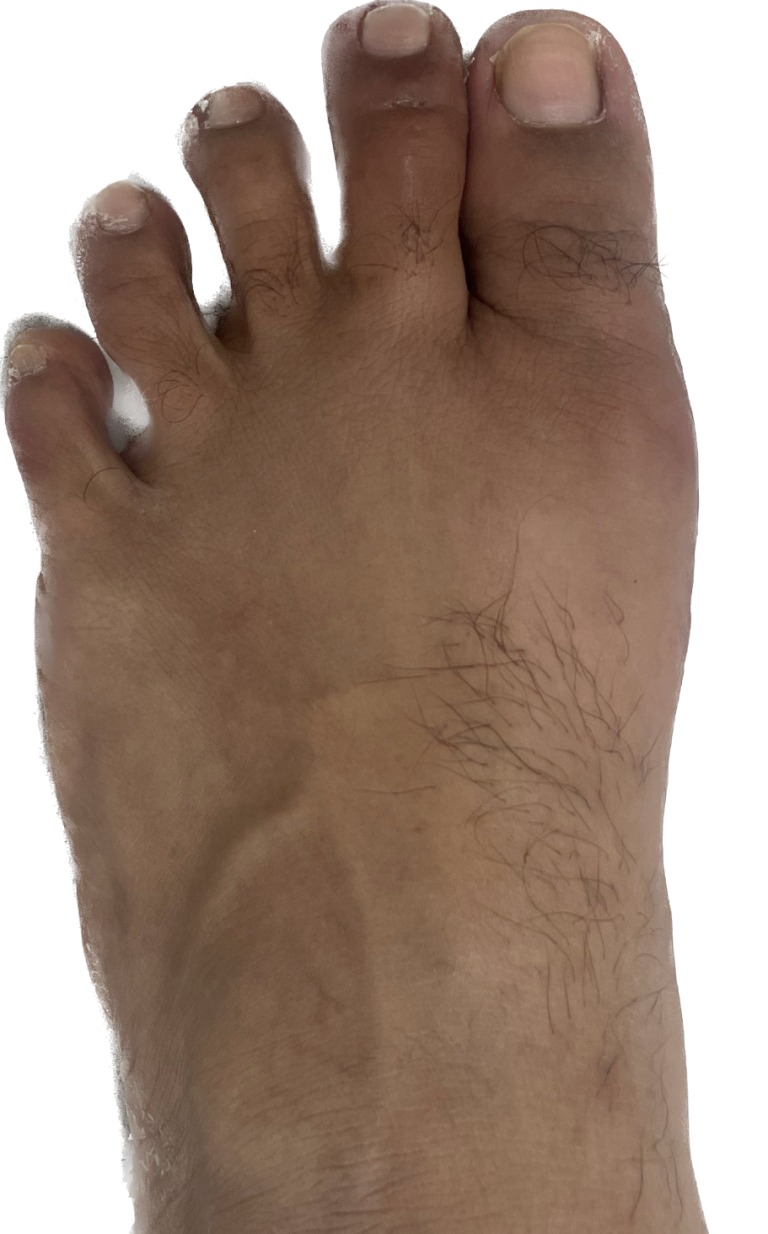Hallux Valgus (Bunions)


What is a bunion (Hallux Valgus)?
This well known deformity is more than just a bump or bunion on the medial side of the foot. The bunion itself is just an overgrowth of new bone and soft tissue. The actual prominence of this bump arises from the metatarsal head drifting inwards.
Causes of Bunions
There is no exact set of causes for Bunions, although likely causes are:
Hereditary factors – if your parents have Bunions it increases the risk of developing them
Traumatic or Injuries
Arthritis – particularly rheumatoid arthritis
Footwear related
What simple non-surgical methods can we try?
Appropriate shoe wear is the key. I advise patients to wear soft lace-up shoes or trainers for commuting to work or when walking long distances. A shoe with a strap or laces means you are less dependent on curling your toes to keep the shoe on. Keep a pair of formal shoes under your desk for meetings. Heels greater than an inch are best avoided as the foot tends to slide down the shoe squashing the toes into the toe box of the shoe. Silicone spacers or bunion cushions may help but can widen the foot further, making shoe wear more difficult.
When would we consider surgery?
If the patient has tried the above measures but the foot still hurts on a fairly regular basis or if the patient is starting to develop problems with the 2nd toe.
What is Bunion Surgery?
Bunion surgery is a type of surgery that is performed to correct a bunion. Bunion (Hallux Valgus) is a foot deformity / bony bump that results in prominence of the inner part of the big toe joint, in particular at the base of the joint where the big toe meets the first metatarsal bone. Bunions can cause pain, swelling, and difficulty walking, and may become worse over time if left untreated.
During bunion surgery, the Mr Hester may remove some of the bone or tissue from the affected joint to realign the toe and relieve pressure on the bunion. The procedure may involve making an incision in the skin over the bunion, and then cutting and repositioning the bones to correct the alignment.
There are several different types of bunion surgery, and the specific procedure used will depend on the severity of the bunion and the individual patient’s needs. Recovery time for Bunion Surgery can vary depending on the type of surgery performed and the extent of the correction needed. It is important to discuss the risks and benefits of bunion surgery with your doctor to determine whether it is the right option for you
What are the Advantages of Bunion Surgery?
A bunion, or hallux valgus deformity, affects the big toe. The aim of bunion surgery is to:
Completely correct the underlying misalignment of the bones and ligaments causing the deformity.
Appropriately realign the joint to ensure minimal risks of recurrence of the bunion.
Improve function
Relief from pain
Cosmetically pleasing appearance
Types of Bunion Surgery
There are several different types of bunion surgery, and the specific procedure used will depend on the severity of the bunion and the individual patient’s needs.
Minimally invasive bunion Surgery, also known as “Keyhole Bunion Surgery”.
Scarf and Akin Osteotomy
Lapidus Procedure for more severe bunions
Bunion Surgery: Frequently Asked Question
Is Bunion surgery covered by insurance?
Bunion surgery can be covered by your medical insurance. The first step is to contact your GP who can provide a referral, your insurance provider will require this in order to authorise a consultation and X-ray with Mr Hester. Following your appointment, our administrative team will contact you to provide all details required in order to authorise the surgery. Some international policies may not require a GP referral or may recommend a chat with their in-house clinical teams to authorise a consultation for bunion surgery with Mr Hester
What is the Private Bunion Surgery cost in London, UK?
The cost for minimally invasive bunion correction will depend on exactly what your surgeon suggests following a consultation and X-rays. The fee is approximately £6000 for one foot and £9000 to correct both feet at the same time. The cost can vary a little depending on sedation or general anaesthesia. The bunion procedures are usually day case procedures meaning that you will not be required to stay overnight.
Can you walk after bunion surgery?
The simple answer is yes. Following the bunion surgery, you will require a postoperative shoe and possibly crutches to help mobilise. Walking will be limited to 5 to 10 minutes an hour for the 14 days. It is important to rest as much as possible over the first few days to promote healing and reduce swelling that allows quicker long term recovery. After 14 days you can gradually increase mobilisation wear trainers from 4weeks following the bunion operation depending on post operative swelling.
What happens if a bunion is left untreated?
Bunions can be a progressive deformity. Though there are ways to reduce some of the symptoms as the bunion deteriorates, such as a splint, custom orthotics or wider footwear, bunion surgery may be required in the long run.
How can I shrink my bunions naturally?
Unfortunately, there is no way to shrink or reverse a bunion without surgical intervention. Splints, custom orthotics and wider footwear can slow how quickly the bunion deteriorates but will not correct or reduce the size. Anti-inflammatory medication can be used to manage acute symptoms in the short term with wide supportive footwear.
How long do you have to stay off your feet after bunion surgery?
Ideally strict elevation with ‘toes above nose’ for the first two weeks, though you can still walk in the surgical shoe when needed. You will have a bulky dressing on for this time period and it will need to stay dry.
At the two week clinic review the big bulky dressing will come down and you can shower the foot until the wound has matured a little. Once healed you can then moisturise and massage the wound and foot to desensitise. After two weeks you will be able to return to most moderate normal activities, excluding high impact activities. Typically longer walks are allowed after 4 weeks and you can transition into a trainer. By 6 weeks you have to ideally be out of the surgical shoe and can start higher impact after 12 weeks.
Swelling can last a number of months post surgery.
How to treat Mild Bunion?
Discomfort from a mild bunion can be helped with a toe splint, custom orthotics or wider footwear. Some mild bunions can also require surgical intervention if they are painful.
Can you reverse a bunion without surgery?
It is not possible to correct or reverse a bunion without surgical intervention.

7 Weeks post bilateral (both sides) Hallux Valgus (bunion) Correction. The swelling for this lady was excellent, really kept the foot elevated

Billateral Hallux Halgus (bunion) and bunionenette correction (Taylors Bunion)


We need your consent to load the translations
We use a third-party service to translate the website content that may collect data about your activity. Please review the details in the privacy policy and accept the service to view the translations.
